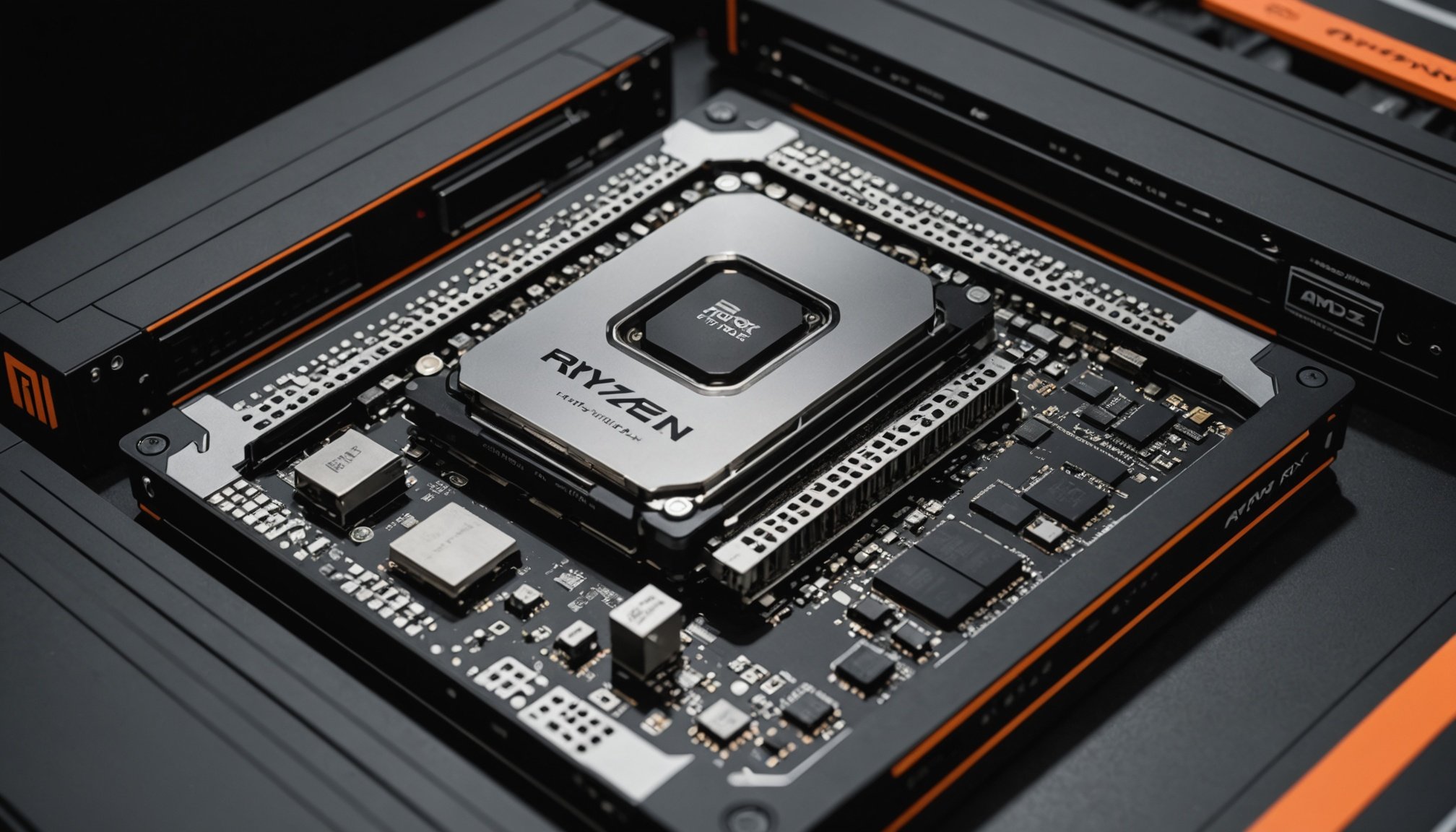Overview of Proxmox VE and AMD Ryzen 9 5900X
Understanding the benefits of Proxmox VE for virtualization begins with its flexibility and efficiency. As an open-source platform, Proxmox VE supports both virtual machines and containers, offering versatile virtualization benefits. Its web-based management interface allows for streamlined server deployment and maintenance, making systems administration more intuitive. Furthermore, Proxmox VE integrates with various storage solutions, enhancing its adaptability for different environments.
On the other hand, the AMD Ryzen 9 5900X showcases impressive features that make it well-suited for virtualization tasks. Housing 12 cores and 24 threads, it delivers outstanding multi-threaded performance, essential for handling multiple virtual environments simultaneously. It also boasts a base clock speed of 3.7 GHz with a boost clock that reaches up to 4.8 GHz, which ensures smooth and efficient processing.
Additional reading : Unlock the full potential of your dell inspiron 7706 2-in-1 for effortless graphic design in adobe creative cloud
The combination of Proxmox VE and the AMD Ryzen 9 5900X is particularly advantageous in scenarios requiring a high-performance virtualization server. Use cases range from running development environments to managing complex enterprise solutions, and even hosting multiple operating systems for testing purposes. This duo offers robust virtualization benefits, providing the stability, performance, and scalability necessary to meet the demanding needs of modern computing infrastructures.
System Requirements for Setting Up Proxmox VE
When preparing for a Proxmox VE installation, understanding the system requirements is crucial for a smooth setup and optimal performance. The minimum hardware specifications include a 64-bit processor, 1GB RAM, and at least a hard drive with 8GB capacity. However, for better performance, a processor with Intel VT or AMD-V virtualisation support, 2GB RAM, and 32GB of hard drive space is recommended.
This might interest you : Ultimate Guide to Building a High-Performance Media Server with NVIDIA Shield TV and External Storage Solutions
BIOS Settings and Configurations
Before installing, ensure your BIOS is configured adequately. This involves enabling virtualisation options like Intel VT-x or AMD-V. Additionally, activating IOMMU can further improve performance, especially if you’re planning to use PCI passthrough.
Hardware Compatibility Considerations
Hardware compatibility extends beyond the basic system requirements. Proxmox VE is versatile but ensuring proper compatibility with network cards and storage controllers can prevent possible installation issues. It’s wise to check the hardware compatibility list (HCL) specific for Proxmox. Certain enterprise-grade network interface cards (NICs) and controllers might provide enhanced support and performance, beneficial for larger-scale deployments.
By aligning your hardware with these requirements and compatibility considerations, you pave the way for a stable and powerful virtualisation environment. Embracing these guidelines not only facilitates smoother operation but also enhances the capabilities of your Proxmox VE system.
Installation Process of Proxmox VE
Proxmox VE installation is straightforward if you follow a step-by-step guide. Begin by preparing the installation media.
Preparing the Installation Media
To start, create a bootable USB with the Proxmox VE ISO. This ensures you have a functional installation medium. First, download the ISO file from the Proxmox official website and verify its integrity using checksums. This step prevents corruption issues during the installation. Use tools like Rufus or Etcher to load the ISO onto a USB drive, creating your bootable USB.
Next, configure your system BIOS to boot from the USB. Access the BIOS settings by pressing specific keys (often Del or F2) during startup. Change the boot order, placing the USB drive at the top. Save changes and exit, readying your machine for installation.
Installing Proxmox VE
With your system set to boot from USB, Proxmox VE installation becomes seamless. The interface guides you through each step. Start by selecting the target hard disk where Proxmox will be installed. Following this, configure essential network settings, ensuring your server has a stable connection.
Set up a strong root password, vital for administrative tasks. Opt-in for email notifications if desired, enhancing management efficiency.
Post-Installation Configurations
Once installed, updating your Proxmox VE installation is crucial for security. Configure storage and virtual networks, essential for optimal performance. Finally, enable firewall and security settings to safeguard your environment.
Configuring Virtual Machines in Proxmox VE
Once you are acquainted with the Proxmox VE dashboard, creating and configuring virtual machines becomes a straightforward task. The dashboard’s user-friendly interface simplifies the initial steps of a virtual machine setup. Begin by selecting the ‘Create VM’ option, which will prompt you to enter essential details such as VM ID, name, and node.
Resource Allocation
Allocating CPU, RAM, and storage is crucial for ensuring the efficiency and performance of your virtual machines. Thoughtful resource allocation begins with considering the workload that the VM will handle. For CPU resources, assign the number of cores based on application needs. RAM allocation requires you to evaluate the memory demand, striking a balance between availability and performance. Storage allocation should account for not only the present requirements but potential future expansion, particularly if data-intensive applications are expected.
Best Practices for Organization
To enhance organization and management, adhere to naming conventions and establish a logical organization pattern. This practice aids in identifying and managing your virtual machines over time. Opt for descriptive names and perhaps incorporate VM roles, making it easier to reference them quickly. Following these steps can significantly streamline the operation and administration of virtual environments within Proxmox VE.
Performance Optimization Techniques
To enhance the efficiency of virtualized environments, one must focus on several performance tuning techniques. Proper adjustment of CPU and memory settings is crucial. Allocating the right amount of resources to each virtual machine (VM) ensures maximum performance without wasting valuable hardware capacity. This involves setting CPU cores and memory limits according to the workload demands.
Utilizing the advanced virtualization optimization features in Proxmox VE can significantly improve resource management. One such feature is memory ballooning, which dynamically adjusts the memory allotted to a VM based on its current needs. This Proxmox VE setting allows more VMs to run simultaneously without requiring additional physical memory.
Network performance is also a key area for optimization in a virtual environment. Techniques for network performance tuning include configuring network settings to minimize latency and maximize throughput. This might involve adjusting network driver settings or employing virtual Local Area Networks (VLANs) to efficiently manage network traffic.
In practice, these performance tuning techniques ensure that the virtualized infrastructure operates efficiently while providing the best possible resource management. By leveraging Proxmox VE settings and optimizing CPU, memory, and network configurations, users can achieve tailored, high-performing virtual environments suitable for their specific needs.
Troubleshooting Common Issues
Experiencing problems with virtual machines on Proxmox VE can be frustrating. Let’s tackle some frequent challenges.
One common issue is virtual machine boot failures. Start by checking if the virtual machine is correctly configured with sufficient resources allocated, such as CPU and RAM. Ensure that the boot priority is set correctly, verifying the boot device under the hardware tab in Proxmox VE. If errors persist, inspect the log files for error messages that might pinpoint the root cause.
For network connectivity issues, first confirm that the network interfaces are properly configured and connected. Check for any discrepancies in IP addresses or subnet masks. It’s crucial to ensure that the virtual machine’s network adapter is linked to the correct virtual bridge. Use command line tools like ping or traceroute to diagnose connectivity from within the virtual machine.
Performance bottlenecks are another frequent hurdle. They may arise due to over-committed resources or high I/O operations. It’s important to regularly monitor your resources through tools like the Proxmox VE dashboard to identify any overloads. Consider redistributing resources or adding more, if necessary. Additionally, if storage is a limiting factor, assess if the disk I/O performance is sufficient for your workloads.
For any unresolved issues, turning to Proxmox VE support forums or documentation can provide further insights and guidance.
Benefits and Features of Proxmox VE
Proxmox VE stands out in the realm of virtualization with its comprehensive set of features. Firstly, it integrates both KVM and LXC, offering a flexible approach for both fully virtualized and containerized environments. This dual virtualization technique adds versatility to system management, allowing for efficient resource allocation based on project needs.
One of the standout benefits of virtualization with Proxmox VE is its cost-effectiveness. As an open-source software, it eliminates hefty licensing fees associated with other virtualization platforms. This makes it an attractive, budget-friendly option for organisations seeking reliable virtualization without compromising on quality.
The Proxmox VE platform also excels in resource efficiency. It supports clustering, which means users can manage multiple servers from a single interface, simplifying administration processes. This consolidation reduces overheads and optimises performance by effectively utilizing existing resources.
Another critical aspect is the strong community support and resources available to users. The Proxmox community forum, detailed documentation, and regular updates provide a robust support network. Users can find solutions to common problems, share tips, and learn from others’ experiences, ensuring a smooth and effective implementation of the software.
These features and benefits together position Proxmox VE as a powerful tool for any virtualization strategy.
Final Thoughts on Creating a Virtualization Server
Setting up a virtualization server requires careful planning, especially when focusing on a high-performance setup. Long-term management and maintenance should be a priority. Regular updates and monitoring can ensure optimal performance and security. Tools like Proxmox VE expertise can help streamline these tasks by providing intuitive management interfaces and robust support for various virtualization technologies.
Future scalability is another critical consideration. Utilizing AMD Ryzen technology offers substantial potential for upgrades. These processors provide exceptional performance, saving costs over time by extending the server’s life and capabilities as demands grow. By allowing for increased core and thread counts, AMD Ryzen ensures that your server can scale with your needs. This is particularly beneficial for businesses that anticipate rapid growth or changes in workloads.
Lastly, it’s essential to find engaging platforms, such as community forums, for continued learning and problem-solving. There, you can connect with other virtualization enthusiasts to exchange tips and solutions, helping you maintain your server efficiently. By embracing these resources, you build not only a technically sound virtualization server but also a support network that enriches your experience.






